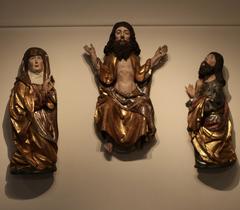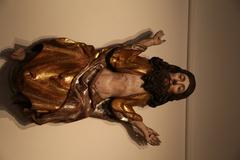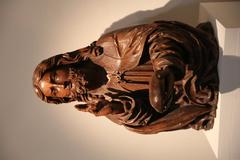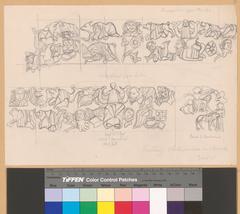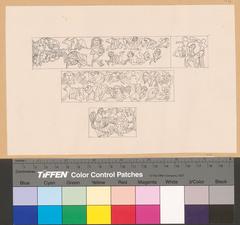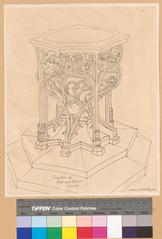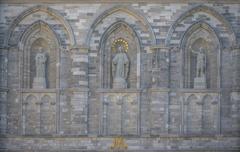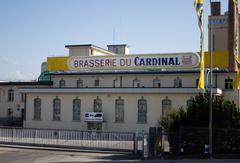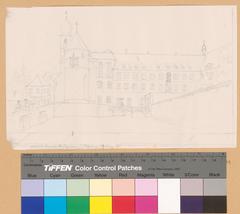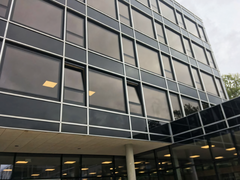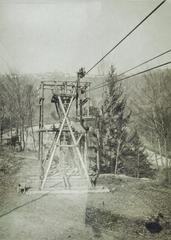
Visiting Cathédrale Saint-Nicolas Kathedrale Sankt Niklaus in Fribourg, Switzerland: A Complete Guide
Date: 23/07/2024
Introduction
Nestled in the heart of Fribourg, Switzerland, the Cathédrale Saint-Nicolas, also known as Kathedrale Sankt Niklaus, stands as a Gothic masterpiece of immense historical and cultural significance. This iconic monument, whose construction began in 1283 under the direction of Bishop Girard de Vuippens, has witnessed centuries of architectural evolution and historical events. The cathedral was initially completed in 1430, but continued to receive additions and modifications, most notably the 76-meter-high bell tower in the 15th century (Fribourg Tourism).
The Cathédrale Saint-Nicolas is renowned for its stunning stained glass windows created by Polish artist Józef Mehoffer between 1896 and 1936, and its intricate Gothic sculptures, including the famous ‘Last Judgment’ tympanum above the main entrance (Art and Architecture). Beyond its architectural and artistic marvels, the cathedral has played a pivotal role in the religious and cultural life of Fribourg, serving as the seat of the Bishop of Lausanne until 1663 and hosting significant events such as the signing of the Treaty of Fribourg in 1481 (Catholic Encyclopedia).
This comprehensive guide aims to provide visitors with essential information on the cathedral’s history, significance, visiting hours, ticket prices, travel tips, and nearby attractions. Whether you are a history enthusiast, an architecture aficionado, or a curious traveler, the Cathédrale Saint-Nicolas offers a rich and immersive experience that is not to be missed.
Table of Contents
- Introduction
- History of Cathédrale Saint-Nicolas
- Artistic Contributions
- Historical Significance
- Visitor Information
- Restoration and Preservation
- Modern-Day Relevance
- Key Historical Events
- Influence on Local Culture
- Educational and Research Contributions
- Special Events and Tours
- Conclusion
- FAQ
History of Cathédrale Saint-Nicolas
Origins and Construction
The Cathédrale Saint-Nicolas, also known as Kathedrale Sankt Niklaus, is a Gothic masterpiece located in the heart of Fribourg, Switzerland. The cathedral’s origins date back to the 13th century when construction began in 1283 under the direction of Bishop Girard de Vuippens. The initial phase of construction was completed in 1430, but the cathedral underwent several modifications and expansions over the centuries (Fribourg Tourism).
Architectural Evolution
The cathedral’s architecture is a testament to the evolving styles and techniques of Gothic architecture. The original design featured a single nave with a polygonal choir, typical of the early Gothic period. In the 14th century, the nave was extended, and the choir was rebuilt to accommodate the growing number of worshippers. The most significant addition came in the 15th century with the construction of the 76-meter-high bell tower, which remains one of the tallest structures in Fribourg (Sacred Destinations).
Artistic Contributions
The Cathédrale Saint-Nicolas is renowned for its stunning stained glass windows, created by the Polish artist Józef Mehoffer between 1896 and 1936. These windows depict various biblical scenes and saints, adding a vibrant splash of color to the cathedral’s interior. The intricate carvings and sculptures, including the famous “Last Judgment” tympanum above the main entrance, are also noteworthy examples of Gothic art (Art and Architecture).
Historical Significance
Throughout its history, the Cathédrale Saint-Nicolas has played a crucial role in the religious and cultural life of Fribourg. It served as the seat of the Bishop of Lausanne until the diocese was moved to Lausanne in 1663. The cathedral has also been a center for various religious ceremonies, including the coronation of bishops and the celebration of major Christian festivals (Catholic Encyclopedia).
Visitor Information
Visiting Hours and Tickets
Visitors can explore the Cathédrale Saint-Nicolas throughout the week. The cathedral is open from Monday to Saturday, 10:00 AM to 5:00 PM, and on Sundays from 2:00 PM to 5:00 PM. Entry is free, but donations are welcome to support the cathedral’s maintenance and preservation.
Travel Tips
The cathedral is easily accessible by public transport. Fribourg’s main train station is just a 10-minute walk from the cathedral. Parking is available nearby for those traveling by car. Don’t forget to check out the cathedral’s gift shop for souvenirs and informational brochures.
Restoration and Preservation
The cathedral has undergone several restoration projects to preserve its historical and architectural integrity. The most extensive restoration took place in the 19th century under the supervision of the Swiss architect Hans Wilhelm Auer. This project aimed to restore the cathedral to its original Gothic splendor, including the repair of the bell tower and the restoration of the stained glass windows (Swiss Heritage Society).
Modern-Day Relevance
Today, the Cathédrale Saint-Nicolas continues to be a significant landmark in Fribourg. It attracts thousands of visitors each year who come to admire its architectural beauty and historical significance. The cathedral also hosts various cultural events, including concerts and art exhibitions, making it a vibrant part of the city’s cultural scene (Fribourg Cultural Events).
Key Historical Events
Several key historical events have taken place at the Cathédrale Saint-Nicolas, further cementing its importance in Swiss history. In 1481, the cathedral was the site of the signing of the Treaty of Fribourg, which marked the city’s entry into the Swiss Confederation. During the Reformation in the 16th century, the cathedral remained a bastion of Catholicism in a region that saw significant Protestant influence (Swiss History).
Influence on Local Culture
The Cathédrale Saint-Nicolas has had a profound influence on the local culture and identity of Fribourg. The cathedral’s iconic bell tower is a symbol of the city, and its chimes can be heard throughout the town, marking the passage of time and significant events. The cathedral’s annual Christmas market and midnight mass are cherished traditions that draw both locals and tourists (Fribourg Traditions).
Educational and Research Contributions
The cathedral is also a center for educational and research activities. It houses a rich archive of historical documents and artifacts that provide valuable insights into the religious and cultural history of Fribourg. Scholars and researchers from around the world visit the cathedral to study its architecture, art, and historical records (Fribourg University).
Special Events and Tours
The Cathédrale Saint-Nicolas offers guided tours that provide in-depth information about its history and architecture. Special events such as organ concerts and art exhibitions are also held regularly. Check the cathedral’s official website for the latest updates and event schedules.
Conclusion
The Cathédrale Saint-Nicolas stands as a testament to the rich history and cultural heritage of Fribourg. Its Gothic architecture, artistic treasures, and historical significance make it a must-visit landmark for anyone interested in Switzerland’s past and present. The cathedral’s ongoing preservation efforts, including extensive restoration projects in the 19th century under Swiss architect Hans Wilhelm Auer, ensure that this magnificent structure will continue to inspire and educate future generations (Swiss Heritage Society).
Today, the Cathédrale Saint-Nicolas remains a vibrant part of Fribourg’s cultural scene, hosting various events such as organ concerts, art exhibitions, and the beloved annual Christmas market. Its influence on local culture is profound, with the cathedral’s iconic bell tower serving as a symbol of the city and its chimes marking significant events (Fribourg Cultural Events). For those planning a visit, the cathedral is easily accessible by public transport and offers guided tours that provide in-depth insights into its history and architecture. Entry is free, though donations are welcome to support its maintenance and preservation (Cathédrale Saint-Nicolas Official Website).
By exploring the Cathédrale Saint-Nicolas, visitors can not only marvel at its architectural beauty but also connect with the rich tapestry of Fribourg’s history and cultural heritage. Plan your visit today to experience the timeless beauty and historical significance of this iconic landmark (Swiss Cultural Heritage).
FAQ
Q: What are the visiting hours for Cathédrale Saint-Nicolas? A: The cathedral is open from Monday to Saturday, 10:00 AM to 5:00 PM, and on Sundays from 2:00 PM to 5:00 PM.
Q: Is there an entry fee to visit the cathedral? A: Entry is free, but donations are welcome to support the cathedral’s maintenance and preservation.
Q: Are guided tours available? A: Yes, guided tours are available. Check the cathedral’s official website for schedules and booking information.
Q: How can I reach the cathedral? A: The cathedral is a 10-minute walk from Fribourg’s main train station. Parking is available nearby for those traveling by car.
Q: What special events are held at the cathedral? A: The cathedral hosts various events, including organ concerts, art exhibitions, and the annual Christmas market.
References
- Fribourg Tourism, n.d., Fribourg Tourism https://www.fribourgtourisme.ch/en/Z10470/cathedral-of-st-nicholas
- Sacred Destinations, n.d., Sacred Destinations https://www.sacred-destinations.com/switzerland/fribourg-cathedral
- Art and Architecture, n.d., Art and Architecture https://www.artandarchitecture.org.uk/fribourg-cathedral
- Catholic Encyclopedia, n.d., Catholic Encyclopedia https://www.newadvent.org/cathen/06238a.htm
- Swiss Heritage Society, n.d., Swiss Heritage Society https://www.heimatschutz.ch/fribourg-cathedral-restoration
- Fribourg Cultural Events, n.d., Fribourg Cultural Events https://www.fribourg-culture.ch/cathedral-events
- Swiss Cultural Heritage, n.d., Swiss Cultural Heritage https://www.culturalheritage.ch/fribourg-cathedral
